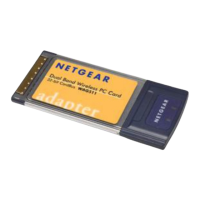Security Section
To prevent unauthorized wireless stations from accessing data transmitted over the network, the
Security section of the Configuration Utility offers secure data encryption, known as WEP, to
better protect your data transmissions.
To activate the WEP Encryption, make sure the Enable WEP Encryption box displays a
checkmark (as shown above).
WEP Encryption options will be displayed, as shown on the previous page. You may make
changes, as detailed here:
1. Select one of the two options: Create with Passphrase or Manual Entry. A Passphrase
makes you easier to enable WEP because it automatically generates the WEP hexadecimal
numbers for the key. If the wireless network Access Point uses a Passphrase, you can also
use that here. Otherwise, you will have to manually enter the hexadecimal numbers by
selecting the Manual Entry option.
2.
Create with Passphrase option: pull down the Key Length options and select the 64-bit
or 128-bit, then type in your Passphrase.
3. Manual Entry option:
a. Pull down the Key Length options and select the 64-bit, 128-bit, or 152-bit
encryption method.
b. In the Encryption Keys fields, specify the WEP keys:
For 64-bit encryption:
Hexadecimal: 10 hexadecimal digits in the range of “A-F”, “a-f” and “0-9”
(e.g. 11AA22BB33)
This table describes the options available from the Configuration section:
13
12
Channel Selection
Specifies a channel only when using an Ad-hoc network mode.
Automatic selection lets you select any unused channel.
Wireless Mode
Specifies working mode: 802.11a, 802.11a Turbo Mode, 802.11b,
802.11g or all.
Start AdHoc Network
Specifies a band to establish an Ad-Hoc network if no matching
SSID is found after scanning all available nodes.
You can start the Ad-Hoc network with 802.11a, 802.11a Turbo
Mode, 802.11b, or 802.11g.
Transmit Power Selects 100%, 50%, 25%, 12%, or Lowest power.
Power Saving Power management options are Off, Normal, and Maximum. Power
management is disabled when Ad-Hoc mode is selected in the
Network Connection field. When the Power Saving setting is Off,
the adapter receives full power from the PC. When the setting is
Normal, the driver turns off power to the PC Card for brief periods
over briefly-spaced time intervals. When the setting is Maximum,
the driver turns off power to the PC Card for longer periods over
more widely-spaced time intervals.
2.4 GHz preamble A long transmit preamble allows the receiver (WAG511 Wireless
PC Card) to lock into the received bit patterns more easily. A short
transmit preamble provides better performance. Default: Auto
(long & short).
Configuration
Description
Network mode
Configurable between 802.11 Ad-Hoc and Infrastructure modes. In
802.11 Ad-Hoc mode, the wireless nodes form their own local
network where the end nodes communicate peer-to-peer without an
Access Point. In Infrastructure mode, the wireless searches all
available wireless channels to associate with an Access Point.
Network Name (SSID)
Enter a 32-character (maximum) Service Set ID in this field; the
characters are case sensitive. When the wireless node is operating in Ad-
hoc mode, this field operates as the Basic Service Set ID (BSSID).
All
wireless nodes in the same network should use the same BSSID.
When in Infrastructure mode, this field defines the Extended Service
Set ID (ESSID). The ESSID assigned to the wireless node is required
to match the Access Point ESSID in order for them to communicate.

